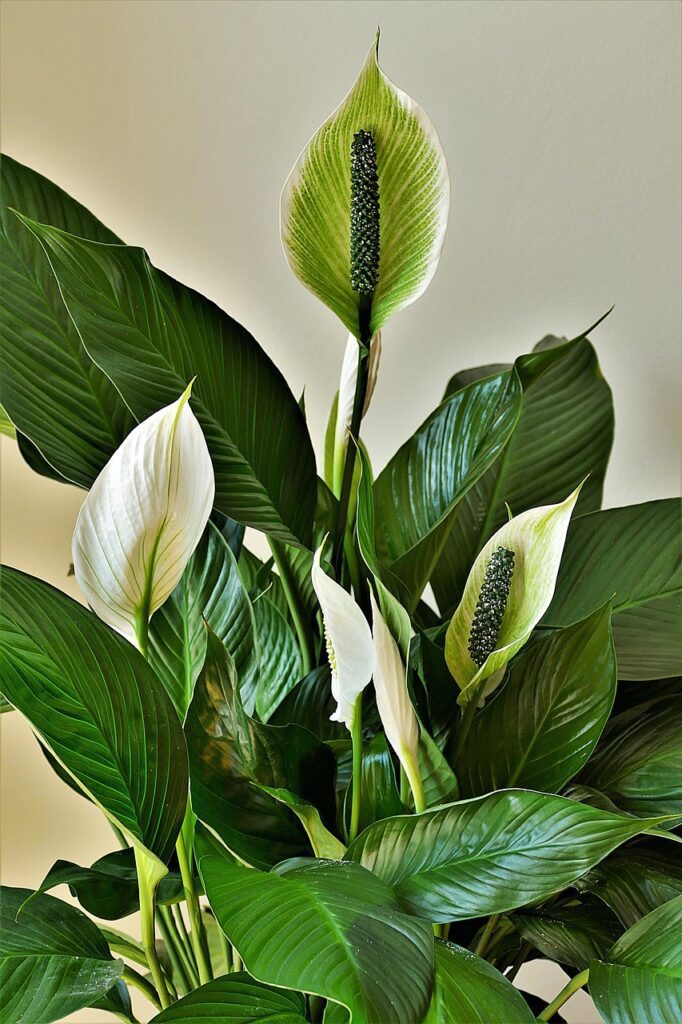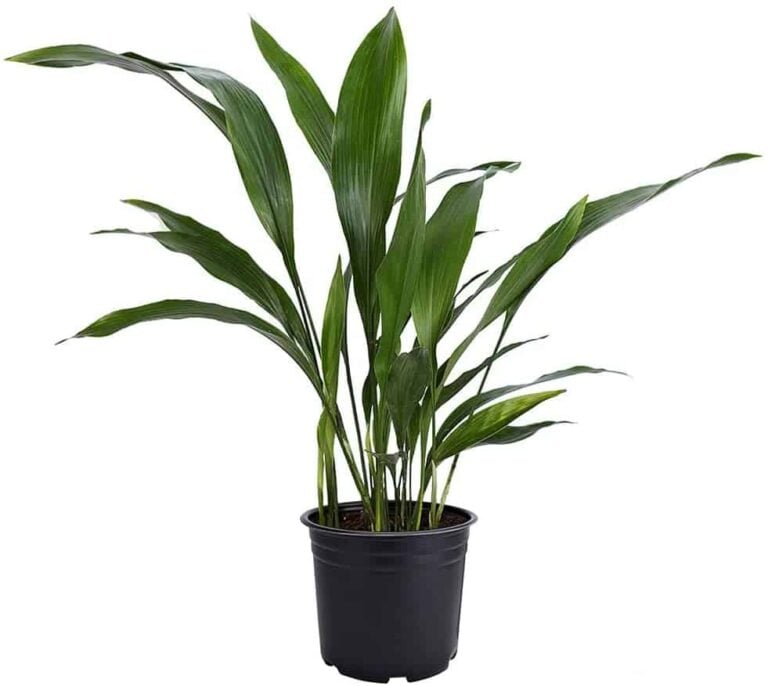Peace Lily Not Flowering: Causes And Solutions For Blooms
Peace lilies are popular houseplants known for their stunning white flowers that create an alluring contrast against their dark green leaves. However, there may come a time when you find your peace lily not flowering, leaving you puzzled and concerned. The lack of flowers on your peace lily could be due to several factors, but identifying the issue and fixing it can help bring your plant back to its blooming glory.

Common reasons for a peace lily not flowering include insufficient light, inadequate nutrients, poor watering habits, and old age. Providing the plant with the right growing conditions can make all the difference in encouraging it to bloom again. Ensuring your peace lily receives bright indirect sunlight, has a moist yet well-draining soil, and is fed with a balanced fertilizer during the growing season are important steps to take.
Understanding the specific needs of your peace lily is crucial to promoting healthy growth, blooming, and propagating if you’d like. By addressing these common issues and implementing proper care, you’ll be on your way to enjoy the captivating beauty of your peace lily’s flowers once again.
Table of Contents
Understanding Peace Lily Flowering
Natural Conditions
Peace lilies (Spathiphyllum) are native to Central America, particularly in regions such as Colombia and Venezuela. In their natural habitat, peace lilies enjoy warm and humid environments with indirect sunlight. The climate in Central America has a substantial influence on the plant’s flowering patterns, therefore it’s crucial to understand these conditions when growing peace lilies indoors.
In their native environment, peace lilies typically receive bright, indirect sunlight filtered through the forest canopy. These plants prefer a stable temperature range between 65 and 86 degrees F (18-30 C), along with a high level of humidity. Creating a similar environment in your home will promote healthy growth and blooming conditions.
Growing Season
If you find your peace lily not flowering, it may not be the right season. The growing season for peace lilies usually occurs during the warmer months of spring and summer. This is when the plant is more likely to produce flowers, as its energy is focused on growth and reproduction. It is essential to provide the adequate care during this period, such as:
- Watering: Keep the soil consistently moist, but avoid overwatering to prevent root rot.
- Feeding: Apply a balanced fertilizer 2-3 times during the growing season to support healthy growth and flowering.
- Temperature and humidity: Maintain stable temperatures and humidity levels to mimic their natural conditions.
During fall and winter, the growth and flowering of peace lilies will naturally slow down. It is important to adjust your care routine accordingly, by reducing watering and stopping fertilizer applications, to prevent problems such as root rot or nutrient burn.
Lifespan
The lifespan of a peace lily directly affects its flowering abilities. As plants age, their ability to reproduce and produce flowers declines. A peace lily not flowering may be due to an old or stressed peace lily. An older plant might not bloom as readily as a younger, healthier plant. However, proper care and maintenance can prolong the lifespan of your peace lily, ensuring it blooms for many years.
Factors that can impact the flowering of peace lilies include:
- Lighting: Insufficient lighting can inhibit blooms; ensure the plant receives bright, indirect sunlight.
- Nutrients: Poor nutrient availability can result in decreased flowering; apply a balanced fertilizer during the growing season.
- Watering: Over or underwatering can stress the plant and reduce blooms; maintain consistent moisture in the soil.
By understanding the peace lily’s natural conditions, growing season, and lifespan, you can create an optimal environment for your plant to thrive and produce beautiful flowers.
Optimum Care for Flowering
Lighting Requirements
Peace lilies require bright indirect light to promote blooming. Although they can adapt to lower light conditions, their flowering will be reduced or non-existent in these circumstances. Place your peace lily near a window with filtered light or in the shade of other plants. Avoid direct sunlight, as it can burn the leaves. A west-facing window is ideal for providing the necessary light levels.
Watering Schedule
Maintaining a consistent watering schedule is crucial for a peace lily’s health and ability to flower. Overwatering or underwatering can both contribute to your peace lily not flowering. Keep the soil moist but not waterlogged. The plant should receive a consistent supply of water, with the top inch of soil being allowed to dry out between waterings. Make sure to use a pot with drainage holes to prevent root rot.
Temperature and Humidity
Peace lilies thrive in temperatures between 65 and 86 degrees F (18-30 C) source. Warmer conditions encourage blooming, while cooler temperatures may result in fewer flowers. High humidity levels are also essential for the plant’s overall health. If your home’s humidity is low, consider using a humidifier or placing a tray of water near the plant, as it can contribute to a better blooming habitat.
Fertilizers and Nutrients
Feeding your peace lily with a balanced, water-soluble fertilizer 2-3 times during the growing season can help promote flowering. Avoid strong or high-phosphorus fertilizers, as they can cause leaf burn or damage the plant’s roots. Nutrient deficiencies, particularly in nitrogen, phosphorus, and potassium, may affect the plant’s ability to produce flowers.
Potting Soil and Drainage
A well-draining potting soil is vital for peace lilies to thrive and bloom. Soil that retains too much moisture can lead to root rot and inhibit flower production. Include amendments such as perlite to improve soil structure and promote healthy root growth. Ensure the pot has drainage holes to allow excess water to escape and prevent waterlogging. Regularly check the soil’s moisture levels and adjust your watering schedule accordingly.
Causes of Peace Lily Not Flowering
Insufficient Light
Peace lilies thrive in bright, indirect sunlight. If you find your peace lily not flowering, insufficient light could be the culprit. These plants can survive in low light, but they need proper lighting to produce blooms. Place your peace lily near a window, ensuring it’s protected from scorch or direct sunlight. Remember, while they tolerate low light, bright, indirect light is essential for blooming.
Temperature Problems
Temperature fluctuations can lead to flowering issues in peace lilies. They are sensitive to cold drafts and extreme temperatures. Keep your plant away from window sills, air conditioning vents, or other areas where it could experience sudden temperature drops. Optimal temperatures for peace lilies range from 65-80°F (18-27°C), so maintain the indoor temperature accordingly.
Overwatering and Root Rot Issues
Overwatering and root rot can be detrimental to a peace lily’s health, affecting its ability to bloom. Drooping, yellow leaves are signs of overwatering. Make sure to water the plant moderately and empty the saucer, if necessary, to avoid standing water. Being attentive to your watering schedule will prevent root rot and encourage blooms.
Nutrient Deficiency
Like all living things, plants require nutrients to thrive. A nutrient deficiency might hinder your peace lily’s flowering capability. To replenish its nutrient value, use balanced fertilizers 2-3 times during the growing season. An ample supply of nutrients will promote healthy, vibrant blooms.
Yellow Leaves and Wilting
Yellow leaves and wilting might signal an issue with your peace lily’s health. Overwatering or nutrient availability could be potential causes, leading to a lack of flowers. Adjusting your watering schedule and providing proper nutrients will help eradicate peace lily not flowering issues, allowing your peace lily to bloom once more.
Repotting and Root-bound Situations
Mature peace lilies and other houseplants often become root-bound, leading to a reduced likelihood of flowering. When you notice cramped roots, it’s time to repot your peace lily. Choose a new pot that is one to two sizes larger than its current home, and use a fresh potting mix that promotes healthy growth. Repotting your root-bound plant will allow it to flourish and produce flowers.
Boosting Peace Lily Flowering
Using Gibberellic Acid and Hormones
Gibberellic acid is a plant hormone that promotes cell division and growth, which can be used to encourage flowering in peace lilies. Applying gibberellic acid will stimulate the development of flower buds and overall energy in the plant. Similarly, other hormones such as cytokinins can be applied to aid in flowering. Remember to use these hormones sparingly and according to the manufacturer’s instructions, as excessive use can negatively affect the plant’s health.
Proper Feeding and Fertilizing Schedule
To avoid your peace lily not flowering, it’s crucial to provide it with proper nutrients. Peace lilies benefit from a balanced houseplant fertilizer. Applying fertilizer 2-3 times during the growing season can ensure your plant gets adequate nutrients for energy production and blooming. It’s important to consider the time of year when fertilizing, as peace lilies naturally produce more flowers during spring and early summer.
- Indirect Light: Peace lilies prefer bright indirect light, which will help them produce more energy for flowering.
- Soil pH: Maintain a soil pH between 5.5 and 7 to support plant health and nutrient uptake.
- Top Dressing: Apply a top dressing of compost or worm castings to enrich the soil and provide additional nutrients.
Pruning and Deadheading
Proper pruning and deadheading are other essential practices to avoid your peace lily not flowering, as well as other ornamental plants such as philodendrons. Removing old spathes, or the colorful modified leaves surrounding the flowers, will give the plant more energy to produce new blooms. Deadheading spent flowers will also promote new flower production in peace lilies. Regular pruning will not only help maintain a pleasing aesthetic, but it will also give the plant more energy and resources to produce stunning flowers.
Appreciating the Beauty of Peace Lily Flowers
Symbolism and Meaning
The Peace Lily is a beautiful plant with rich, green, robust foliage that thrives in low light conditions. This easy-to-grow plant is famous for its elegant white spathe and spadix, which contribute to its symbolism of peace. The white spathe is often seen as a symbol of purity and tranquility, while the spadix symbolizes spiritual growth and rebirth.
In addition to peace and purity, the flower is also associated with innocence and new beginnings. As a result, the peace lily is a popular choice for gifting in various occasions, such as funerals or celebrations of new life milestones.
Cultural Significance
This charming flower has cultural significance across different societies and traditions. In some regions, it is considered a symbol of strong relationships, while other cultures appreciate it for its ability to bring harmony and balance to the environment. The Peace Lily’s hardiness and resilience in low light conditions further add to its symbolism of strength and endurance.
Additionally, the plant’s preference for bright indirect light signifies its adaptability and ability to prosper in various settings. Peace Lilies are often placed near windows or other sources of light, creating a visual reminder of the importance of inner illumination and personal growth.
Aesthetic Value
The aesthetic value of the Peace Lily comes not only from its striking white spathe and spadix but also from its lush, green foliage. The bold contrast between the delicate white flower and the hearty leaves creates an eye-catching display that complements various interior designs and styles.
Moreover, Peace Lilies are versatile plants that can thrive in a range of lighting conditions, from low light to bright indirect light. This adaptability makes them an excellent choice for homeowners and plant enthusiasts who desire an attractive indoor plant that does not require constant attention. By maintaining proper care techniques, these resilient plants will continue to produce captivating flowers and foliage, further enhancing their aesthetic appeal.



